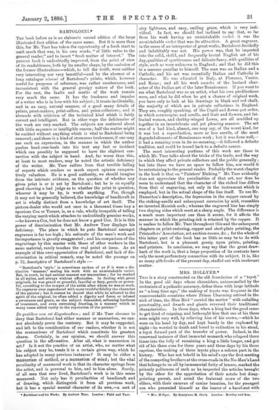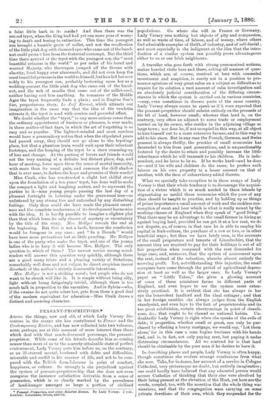MRS. HOLLYE R.*
Tins is a story constructed on the old foundation of a "tryst." In the good old days whose chroniclers, untrammelled by the restraints of a pedantic accuracy, define them with large latitude as "a long time ago," the making of trysts was frequent in the unaccountable countries where Prince Charming arrived in the nick of time, the Blue Bird "carried the matter" with unfailing punctuality, and dwarfs and giants reversed their traditional characteristics. In those days, when a king had the good sense to get tired of reigning, and bethought him that one of his three sons might very well, by relieving him of his crown,—which he wore on his head by day, and kept handy in the cupboard by night—be worried to death and bored to extinction in his stead, a tryst formed part of the transfer of power. Indeed, in the renowned instance of that immortal monarch who relapsed three times into the folly of remaining a king a little longer, and got rid of his three sons for three years and three days by his three caprices, the making of three trysts plays a solemn part in the history. Who has not beheld in his mind's eye the first meeting of the competing brothers at the cross-roads in the No-Man's Land that belongs to us all by immemorial fixity of tenure, marked the princely politeness of each as he inspected the articles brought by the other for the approbation of their astute but disap- pointing parent, and noted the fraternal scorn of the two elders, with their caravan of canine beauties, for the youngest son who presented himself as the bearer of a hazel-nut with • Mrs. Thrlysr. By Georgia= M. Orailt. London : Bentley and Son.
a faint little bark in its inside ? And then there was the second tryst, when the King had had yet one more year of worry- ing to death and boring to extinction. This time the youngest son brought a humbie grain of millet, and not the recollection of the little pink dog with diamond eyes who came out of the hazel- nut could protect him from the fraternal contempt. But the third time there arrived at the tryst with the youngest son, the "most beautiful princess in the world" as per order of his bored and worried Majesty, who thereupon jumped off the throne with alacrity, lived happy ever afterwards, and did not even keep the most beautiful princess in the world to himself, but handed her over nobly to his youngest son, probably bestowing upon her as a wedding-present the little pink dog who came out of the hazel- nut, and the web of muslin that came out of the millet-seed, neither having cost him anything. In romances of the Middle Ages the tryst frequently finds a place ; and in Eugene Sue's fine, preposterous story, Le Juif Errant, which attracts our imagination in the same way that the idea of the vendetta attracts it, the tryst is used with sombre and powerful effect.
We doubt whether the "tryst," in any more serious sense than the ordinary appointment of business or pleasure, is ever made, in these matter-of-fact days, in which the art of forgetting is so easy and so popular. The lightest-minded and most careless would have a premonitory notion that when the stipulated years had passed away, they should not go alone to the trysting- place, but that a phantom train would wait upon their reluctant footsteps, and the keeping of the tryst be a stern summing-up of loss and change. At the parting of lovers and friends would not the very naming of a definite but distant place, day, and hour of meeting, force upon them the sense of mortal insecurity, with more than its usual pain, and summon the chill shadow that is ever near, to darken the hope and promise of their words?
Miss Craik, who has constructed a slight but skilful story upon the foundation of a ten.years' tryst, has done well to make the compact a light and laughing matter, and to represent the parties to it—nine young, people passing the last day of a pleasant fortnight in loitering under the greenwood tree—as unfettered by any strong ties and untouched by any disturbing feelings. Only thus could she have made the pleasant smart- ness and the complete modernness of its development harmonise with the idea. It is hardly possible to imagine a slighter plot than that which loses its only chance of mystery or uncertainty by the title of the story. .31rs. Rollyer reveals the end at the beginning. But this is not a fault, because the conclusion would be foregone in any case ; and "In a Decade" would have been more pretentious but as little puzzling. Mr. Hollyer is one of the party who make the tryst, and one of the young ladies who is to keep it will become Mrs. Hollyer. The only question is, which of them ? The newest novice among novel- readers will answer this question very quickly, although there are a good many feints and a pleasing variety of flirtations, remarkably well done and not vulgar, to divert suspicion (never diverted) of the author's strictly honourable intentions.
Mrs. Hollyer is not a striking novel; but people who do not want to be struck will like it. It is simple without being silly, light without being fatigningly trivial, although there is too much talk in proportion to the narrative. And in Sylvia—who, if the swains do not quite adore her, gets from them a good deal of the modern equivalent for adoration—Miss Craik draws a distinct and amusing character.











































 Previous page
Previous page